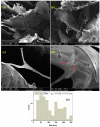H2O2-PLA-(Alg)2Ca Hydrogel Enriched in Matrigel® Promotes Diabetic Wound Healing
- PMID: 36986719
- PMCID: PMC10057140
- DOI: 10.3390/pharmaceutics15030857
H2O2-PLA-(Alg)2Ca Hydrogel Enriched in Matrigel® Promotes Diabetic Wound Healing
Abstract
Hydrogel-based dressings exhibit suitable features for successful wound healing, including flexibility, high water-vapor permeability and moisture retention, and exudate absorption capacity. Moreover, enriching the hydrogel matrix with additional therapeutic components has the potential to generate synergistic results. Thus, the present study centered on diabetic wound healing using a Matrigel-enriched alginate hydrogel embedded with polylactic acid (PLA) microspheres containing hydrogen peroxide (H2O2). The synthesis and physicochemical characterization of the samples, performed to evidence their compositional and microstructural features, swelling, and oxygen-entrapping capacity, were reported. For investigating the three-fold goal of the designed dressings (i.e., releasing oxygen at the wound site and maintaining a moist environment for faster healing, ensuring the absorption of a significant amount of exudate, and providing biocompatibility), in vivo biological tests on wounds of diabetic mice were approached. Evaluating multiple aspects during the healing process, the obtained composite material proved its efficiency for wound dressing applications by accelerating wound healing and promoting angiogenesis in diabetic skin injuries.
Keywords: Matrigel; alginate-hydrogel-based dressing; oxygen-enriched polylactic acid microspheres; skin; wound healing.
Conflict of interest statement
The authors declare no conflict of interest.
Figures
















References
-
- Atma Y. Synthesis and Application of Fish Gelatin for Hydrogels/Composite Hydrogels: A Review. Biointerface Res. Appl. Chem. 2022;12:3966–3976. doi: 10.33263/briac123.39663976. - DOI
LinkOut - more resources
Full Text Sources

